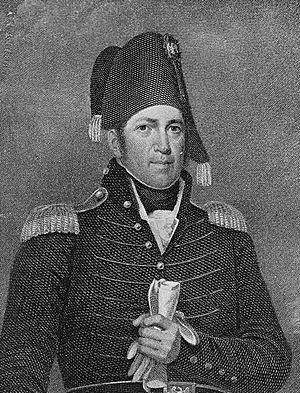Raid on Gananoque facts for kids
Quick facts for kids Raid on Gananoque |
|||||||
|---|---|---|---|---|---|---|---|
| Part of War of 1812 | |||||||
|
|||||||
| Belligerents | |||||||
| Commanders and leaders | |||||||
| Benjamin Forsyth | Joel Stone | ||||||
| Units involved | |||||||
| Regiment of Riflemen New York Militia |
2nd Regiment of Leeds Militia | ||||||
| Strength | |||||||
| 110 regular infantry and militia | About 100 militia | ||||||
| Casualties and losses | |||||||
| 1 killed 10 wounded |
8 killed 8 prisoners Some wounded Stores seized Government depot burned 3,000 ball cartridges 41 muskets 150 barrels of provisions |
||||||
The Raid on Gananoque was a military attack during the War of 1812. It happened on September 21, 1812. Soldiers from the United States Army attacked the town of Gananoque in Upper Canada.
The Americans wanted to take ammunition and supplies for their own troops. Gananoque was an important stop for supplies moving between Montreal and Kingston. Kingston was a main base for the British navy on the Great Lakes.
Captain Benjamin Forsyth led the American soldiers. They left Ogdensburg, New York and sailed to Gananoque. There, they met soldiers from the 2nd Regiment of Leeds Militia. The British militia had to retreat. The Americans then destroyed a supply building. They returned to the United States with the supplies they had taken. After this raid, the British made their defenses stronger along the St. Lawrence River.
Contents
Why the Raid Happened: Getting Supplies
Gananoque is about 20 kilometers (12 miles) from Kingston. Kingston was the main base for the British navy on the Great Lakes. Gananoque was a key place for storing ammunition, supplies, and food. These items were moved along the St. Lawrence River between Kingston and Montreal.
The town was also the last stop for groups of supply boats (called convoys) traveling between Montreal and Kingston. This made it a vital point for communication between the two cities. Joel Stone, an American Loyalist, started the town in 1789. He had moved to Upper Canada after the American Revolutionary War.
In August 1812, there was a temporary stop to fighting. This agreement was between General Sir George Prévost (British commander) and Major General Henry Dearborn (American commander). However, U.S. President James Madison ended this agreement on August 15.
The American soldiers at Sackets Harbor, New York were running low on supplies. Their commander, Brigadier General Jacob Brown, even bought blankets for his men. A group of US Regiment of Riflemen soldiers joined them on September 14. But these new soldiers did not have enough ammunition.
Since his leaders did not help him, General Brown decided to raid Canadian land. He wanted to get supplies and ammunition. He had heard that Gananoque was not well protected.
The Attack on Gananoque
General Brown ordered Captain Benjamin Forsyth to lead the attack. Captain Forsyth was from the Regiment of Riflemen. He took 90 of his own men and 20 soldiers from the New York Militia. Their goal was to take supplies and ammunition.
The American force left Ogdensburg, New York on September 18. They traveled in boats and arrived at Gananoque on September 21, 1813. Forsyth landed his men about 2 kilometers (1.2 miles) west of the town. They then moved towards Gananoque.
The Americans surprised the 2nd Regiment of the Leeds Militia. This group was led by Colonel Joel Stone. Two British soldiers on horseback saw the Americans coming. They fired at them, wounding one. But both British soldiers escaped and warned the town.
When the Americans arrived, about 100 Leeds Militia soldiers met them. These militia soldiers, led by Lieutenant Levi Soper, began firing. Forsyth moved his troops closer, to about 90 meters (100 yards) from the Leeds Militia. Then he ordered his men to charge forward. This forced the British militia to retreat across a bridge.
Forsyth's troops entered Gananoque. They took 3,000 ammunition cartridges and 41 muskets. They also destroyed 150 barrels of food supplies. The Americans searched the supply building and destroyed Colonel Stone's home.
The Americans had one soldier killed and ten wounded. The British had eight soldiers killed and eight taken as prisoners. Others were wounded, including Colonel Stone's wife. After just 30 minutes, the Americans returned to their boats with the captured goods. They then headed back to Ogdensburg.
What Happened Next
The British sent a group to try and stop Forsyth, but they could not find his force. The British group then landed at Burton's Point. They burned a small fort (called a blockhouse) and several boats. After that, they returned to Canada.
Captain Forsyth moved his troops back to Ogdensburg. On February 7, 1813, he raided across the border again. This time, he attacked Elizabethtown. The British responded with their own attack on Ogdensburg, known as the Battle of Ogdensburg.
The British realized their supply routes were in danger. They started moving their equipment and troops in protected groups (convoys). Work on a blockhouse (small fort) began in Gananoque in January 1813. It was finished later that year.
Remembering the Raid: Historic Plaque
To mark the site of the raid, a special plaque was put up. It is an Ontario provincial plaque located at the Gananoque Power Company.
On September 21, 1812, during the War of 1812, a United States force of some 200 regulars and militia under Captain Benjamin Forsyth attacked Gananoque, Ontario. The village was an important forwarding point for supplies moving up the St. Lawrence River from Montreal to Kingston and was garrisoned by a detachment of the 2nd Leeds Militia under Colonel Joel Stone. After a spirited resistance, Colonel Stone withdrew his force comprising two subalterns and about forty soldiers, and the Americans seized the stores and burned the government depot. As a result of this raid, a blockhouse was begun in Gananoque the following month and completed in 1813.
—Raid on Gananoque plaque


